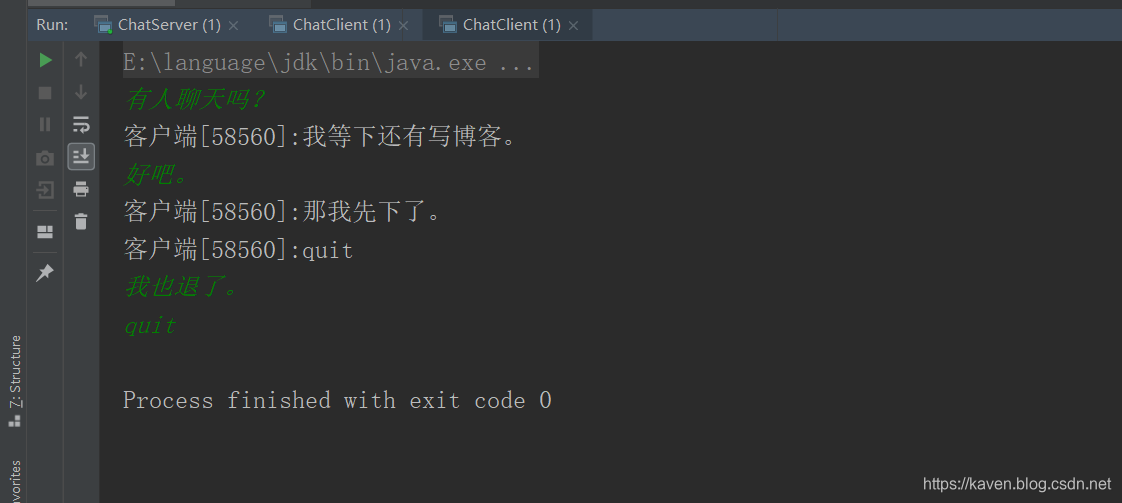Java网络编程-Socket编程初涉四(NIO模型的简易多人聊天室)
什么是NIO模型呢?
之前版本
Java网络编程-Socket编程初涉三(伪异步I/O模型的简易多人聊天室)
服务器
这里使用Channel、Selector、Buffer来实现一个NIO模型的服务器,服务器的主要逻辑如下:
- 首先创建
ServerSocketChannel(服务器管道),拿到关于该ServerSocketChannel的ServerSocket,并且将ServerSocket绑定端口(源码中也间接实现了监听端口,之前的版本有说过,这里就不再赘述了),再创建Selector,将创建的ServerSocketChannel的ACCEPT事件注册到Selector上(也就是当有客户端连接服务器时触发事件)。 - 当有客户端连接后(即
Selector监听到ServerSocketChannel的ACCEPT事件触发了),就获取该客户端的SocketChannel,并将SocketChannel的READ事件注册到Selector上(当有客户端发送消息给服务器时触发)。 - 当有客户端发送消息给服务器时,服务器将该消息转发给其他用户,因为在线用户的
SocketChannel都在Selector上注册了READ事件,所以服务器可以很方便的拿到用户的SocketChannel(所有在线用户的管道),所以服务器转发消息就变得十分简单了;最后还要判断用户输入的消息是否是要准备退出,如果用户要退出,就移除该用户SocketChannel的READ事件,并且提醒Selector。
像BIO模型和伪异步I/O模型实现的服务器,当有客户端连接服务器后,服务器需要创建一个线程来与用户进行通信,当客户端连接请求并发数很大时,服务器需要创建的线程就非常多了,这样带来的上下文切换、内存开销都非常大,并且创建的线程还是阻塞式的,性能较差。而NIO模型,客户端与服务器通信是通过Channel、Buffer(BIO模型和伪异步I/O模型是使用Stream),并且当客户端连接服务器时,NIO模型不需要创建线程,只需要将用户管道的READ事件注册到Selector即可,用户发送消息给服务器就会触发该事件,而不需要创建线程去一直阻塞式的监听用户发送过来消息,有了Selector,实现非阻塞通信就变得很简单了。
代码中注释还是比较详细的,相信大家都能看懂。如果对ByteBuffer的读、写模式不太懂,可以看下面这篇博客的相关部分。
使用Java的IO与NIO来Copy文件的四种方法实现以及性能对比
package nio.chatroom.server;
import java.io.*;
import java.net.InetSocketAddress;
import java.nio.ByteBuffer;
import java.nio.channels.*;
import java.nio.charset.Charset;
import java.util.Set;
public class ChatServer {
// 默认端口
private static final int DEFAULT_PORT = 8888;
private static final String QUIT = "quit";
// 缓冲区大小
private static final int BUFFER = 1024;
private ServerSocketChannel server;
private Selector selector;
// 读取 buffer
private ByteBuffer rBuffer = ByteBuffer.allocate(BUFFER);
// 写入 buffer
private ByteBuffer wBuffer = ByteBuffer.allocate(BUFFER);
private Charset charset = Charset.forName("UTF-8");
// 自定义端口
private int port;
public ChatServer(){
this(DEFAULT_PORT);
}
public ChatServer(int port){
this.port = port;
}
public void start(){
try {
// 打开一个ServerSocket 的 Channel
server = ServerSocketChannel.open();
// 设置非阻塞
server.configureBlocking(false);
// 得到一个关于该ServerSocketChannel的ServerSocket、并且绑定端口
server.socket().bind(new InetSocketAddress(port));
// 打开Selector
selector = Selector.open();
// 把ServerSocketChannel注册到Selector , 设置监听事件为ACCEPT
server.register(selector , SelectionKey.OP_ACCEPT);
System.out.println("启动服务器,监听端口:"+ port +"...");
while(true){
// 本身是阻塞式调用
selector.select();
// 触发事件集
Set<SelectionKey> selectionKeys = selector.selectedKeys();
for(SelectionKey key : selectionKeys){
// 处理被触发的事件
handles(key);
}
// 处理完成后,手动清空
selectionKeys.clear();
}
} catch (IOException e) {
e.printStackTrace();
} finally{
close(selector);
}
}
private boolean readyToQuit(String msg){
return QUIT.equalsIgnoreCase(msg);
}
private synchronized void close(Closeable closeable){
if(closeable != null){
try {
closeable.close();
} catch (IOException e) {
e.printStackTrace();
}
}
}
private String receive(SocketChannel client) throws IOException {
// 写模式
rBuffer.clear();
while((client.read(rBuffer)) > 0);
// 读模式
rBuffer.flip();
return String.valueOf(charset.decode(rBuffer));
}
private void forwardMessage(SocketChannel client , String fwdMsg) throws IOException {
for(SelectionKey key : selector.keys()){
Channel connectedClient = key.channel();
if(connectedClient instanceof ServerSocketChannel){
continue;
}
if(key.isValid() && !client.equals(connectedClient)){
// 写模式
wBuffer.clear();
wBuffer.put(charset.encode(getClientName(client) +":"+fwdMsg));
// 读模式
wBuffer.flip();
while(wBuffer.hasRemaining()){
((SocketChannel) connectedClient).write(wBuffer);
}
}
}
}
private String getClientName(SocketChannel client){
return "客户端["+client.socket().getPort()+"]";
}
private void handles(SelectionKey key) throws IOException {
// ACCEPT事件 - 和客户端建立了连接
if(key.isAcceptable()){
ServerSocketChannel server = (ServerSocketChannel) key.channel();
SocketChannel client = server.accept();
// 设置成非阻塞
client.configureBlocking(false);
client.register(selector , SelectionKey.OP_READ);
System.out.println(getClientName(client)+"已连接");
}
// READ事件 - 客户端发送了消息
else if(key.isReadable()){
SocketChannel client = (SocketChannel) key.channel();
String fwdMsg = receive(client);
if(fwdMsg.isEmpty()){
// 客户端异常 , 不再监听这个事件
key.cancel();
// 更新监听事件状态
selector.wakeup();
} else{
forwardMessage(client , fwdMsg);
// 检查用户是否准备退出
if(readyToQuit(fwdMsg)){
key.cancel();
selector.wakeup();
System.out.println(getClientName(client)+"已断开");
}
}
}
}
public static void main(String[] args) {
ChatServer server = new ChatServer();
server.start();
}
}
客户端
如果看懂了服务器端的代码逻辑,客户端代码逻辑应该很容易看懂。
- 获取一个
SocketChannel,并且设置成非阻塞(需要手动设置,默认为阻塞),再获取一个Selector,并将SocketChannel的CONNECT事件注册到Selector上(客户端连接服务器时触发)。 - 当有
SocketChannel的CONNECT事件触发后,也就意味着有客户端连接上了服务器,所以需要创建一个线程来监听用户的输入(这个实现不需要变),并且还需要将SocketChannel的READ事件注册到Selector上(当服务器转发其他用户的消息时触发,触发后,客户端直接打印服务器转发的消息即可)。
package nio.chatroom.client;
import java.io.*;
import java.net.InetSocketAddress;
import java.nio.ByteBuffer;
import java.nio.channels.ClosedSelectorException;
import java.nio.channels.SelectionKey;
import java.nio.channels.Selector;
import java.nio.channels.SocketChannel;
import java.nio.charset.Charset;
import java.util.Set;
public class ChatClient {
private static final String DEFAULT_SERVER_HOST = "127.0.0.1";
private static final int DEFAULT_SERVER_PORT = 8888;
private static final int BUFFER = 1024;
private static final String QUIT = "quit";
private String host;
private int port;
private SocketChannel client;
private ByteBuffer rBuffer = ByteBuffer.allocate(BUFFER);
private ByteBuffer wBuffer = ByteBuffer.allocate(BUFFER);
private Selector selector;
private Charset charset = Charset.forName("UTF-8");
public ChatClient(){
this(DEFAULT_SERVER_HOST , DEFAULT_SERVER_PORT);
}
public ChatClient(String host , int port){
this.host = host;
this.port = port;
}
// 检查用户是否准备退出
public boolean readyToQuit(String msg){
return QUIT.equalsIgnoreCase(msg);
}
public void close(Closeable closeable){
if(closeable != null){
try {
closeable.close();
} catch (IOException e) {
e.printStackTrace();
}
}
}
public void start(){
try {
client = SocketChannel.open();
// 设置非阻塞
client.configureBlocking(false);
selector = Selector.open();
client.register(selector , SelectionKey.OP_CONNECT);
client.connect(new InetSocketAddress(host , port));
while(true){
selector.select();
Set<SelectionKey> selectionKeys = selector.selectedKeys();
for(SelectionKey key : selectionKeys){
handles(key);
}
}
} catch (IOException e) {
e.printStackTrace();
} catch (ClosedSelectorException e){
// 用户正常退出,产生的异常
} finally {
close(selector);
}
}
private void handles(SelectionKey key) throws IOException {
// CONNECT事件 - 连接就绪事件
if(key.isConnectable()){
SocketChannel client = (SocketChannel) key.channel();
if(client.isConnectionPending()){
client.finishConnect();
// 处理用户的输入
new Thread(new UserInputHandler(this)).start();
}
client.register(selector , SelectionKey.OP_READ);
}
// READ事件 - 服务器转发消息
else if(key.isReadable()){
SocketChannel client = (SocketChannel) key.channel();
String msg = receive(client);
if(msg.isEmpty()){
// 服务器异常
close(selector);
}
else{
System.out.println(msg);
}
}
}
private String receive(SocketChannel client) throws IOException {
// 写模式
rBuffer.clear();
while(client.read(rBuffer) > 0);
// 写模式
rBuffer.flip();
return String.valueOf(charset.decode(rBuffer));
}
public void send(String msg) throws IOException {
if(msg.isEmpty()){
return ;
}
// 写模式
wBuffer.clear();
wBuffer.put(charset.encode(msg));
wBuffer.flip();
while(wBuffer.hasRemaining()){
client.write(wBuffer);
}
// 检查用户是否准备退出
if(readyToQuit(msg)){
close(selector);
}
}
public static void main(String[] args) {
ChatClient client = new ChatClient();
client.start();
}
}
这个类没有改动,就不说了。
package nio.chatroom.client;
import java.io.BufferedReader;
import java.io.IOException;
import java.io.InputStreamReader;
public class UserInputHandler implements Runnable{
private ChatClient client;
public UserInputHandler(ChatClient client){
this.client = client;
}
@Override
public void run() {
try {
// 等待用户输入消息
BufferedReader consoleReader = new BufferedReader(
new InputStreamReader(System.in)
);
while(true){
String input = consoleReader.readLine();
// 向服务器发送消息
client.send(input);
//检查用户是否准备退出
if(client.readyToQuit(input)){
break;
}
}
} catch (IOException e){
e.printStackTrace();
}
}
}
这里我们便实现了一个NIO模型的简易多人聊天室,大家可以动手试一试。
测试



测试没什么问题。
如果有说错的地方,请大家不吝赐教(记得留言哦~~~~)。
